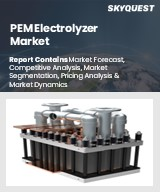
세계 PEM 전해조 시장 규모는 2023년에 5억 600만 달러로 평가되었으며, 2024년 6억 6,000만 달러에서 2032년에는 55억 2,450만 달러로 성장할 것으로 예측되며, 예측 기간(2025-2032년) 동안 CAGR 30.42%로 성장할 전망입니다.
세계 PEM 전해조 시장은 다양한 분야의 그린 수소 수요 증가에 힘입어 강력한 성장세를 보이고 있습니다. 양성자 교환막 기술에 대한 주요 투자는 엄격한 배출 감소 목표를 달성하고 수소 생산과 순도를 최적화하는 것을 목표로 하고 있습니다. 촉매 재료와 멤브레인 내구성의 혁신은 시스템의 효율을 높이고 있습니다. 전해조 제조업체와 재생에너지 공급업체와의 전략적 파트너십은 다양한 재생에너지원과 연계된 고체 고분자 연료전지 시스템의 확장 가능한 배포를 촉진하고, 청정에너지로의 전환에 있어 그 중요성을 강조하고 있습니다. 또한, 센서 및 IoT 플랫폼과 같은 디지털 모니터링 기술을 통합하여 실시간 성능 추적, 예지보전, 다운타임 감소를 가능하게 합니다. 소프트웨어 회사와의 공동 이니셔티브를 통해 고급 분석 도구의 개발을 촉진하고, 성능 최적화 및 라이프사이클 비용 절감을 더욱 촉진하고 있습니다.
Global PEM Electrolyzer Market Size was valued at USD 506 Million in 2023 poised to grow from USD 660 Million in 2024 to USD 5524.5 Million by 2032, growing at a CAGR of 30.42% in the forecast period (2025-2032).
The global PEM electrolyzer market is experiencing robust growth fueled by the increasing demand for green hydrogen across various sectors. Major investments in proton exchange membrane technologies aim to meet stringent emissions reduction goals, optimizing hydrogen production and purity. Innovations in catalyst materials and membrane durability are enhancing system efficiency. Strategic partnerships between electrolyzer manufacturers and renewable energy providers are facilitating the scalable deployment of PEM systems linked to diverse renewable sources, highlighting their significance in the transition to cleaner energy. Additionally, the integration of digital monitoring technologies, such as sensors and IoT platforms, allows for real-time performance tracking, predictive maintenance, and reduced downtime. Collaborative initiatives with software companies are fostering the development of advanced analytics tools, further optimizing performance and reducing lifecycle costs.
Top-down and bottom-up approaches were used to estimate and validate the size of the Global PEM Electrolyzer market and to estimate the size of various other dependent submarkets. The research methodology used to estimate the market size includes the following details: The key players in the market were identified through secondary research, and their market shares in the respective regions were determined through primary and secondary research. This entire procedure includes the study of the annual and financial reports of the top market players and extensive interviews for key insights from industry leaders such as CEOs, VPs, directors, and marketing executives. All percentage shares split, and breakdowns were determined using secondary sources and verified through Primary sources. All possible parameters that affect the markets covered in this research study have been accounted for, viewed in extensive detail, verified through primary research, and analyzed to get the final quantitative and qualitative data.
Global PEM Electrolyzer Market Segments Analysis
The global PEM electrolyzer market is segmented based on application, capacity range, installation, and region. In terms of application, the market is divided into green hydrogen production, power-to-gas, grid stabilization, and others. Based on capacity range, the market is grouped into below 1 MW, 1-5 MW, 5-10 MW, and above 10 MW. Based on installation, the market is bifurcated into centralized and decentralized. Based on region, the market is segmented into North America, Europe, Asia-Pacific, Central & South America and the Middle East & Africa.
Driver of the Global PEM Electrolyzer Market
The growing demand for low-emission solutions across various industries, including ammonia production, oil refining, and steel manufacturing, is significantly propelling the need for green hydrogen, thereby boosting the global market for PEM electrolyzers. These systems are increasingly preferred due to their capability to generate high-purity hydrogen efficiently and their swift response to changes in energy supply, making them ideal for use with variable renewable energy sources. As industries enhance their efforts toward decarbonization, PEM electrolyzers are emerging as essential elements in the development of clean hydrogen value chains, further contributing to their market expansion.
Restraints in the Global PEM Electrolyzer Market
Despite technological progress, the Global PEM Electrolyzer market faces considerable challenges due to the high costs associated with catalyst materials and the intricate designs of the membranes. The restricted production scale results in elevated costs per unit, hindering the broader adoption of PEM electrolyzers. For many potential market entrants, the substantial initial investment remains a significant barrier, which persists until manufacturers can achieve greater design standardization and enhanced mass production capabilities. Until these issues are addressed, the market's growth and accessibility will continue to be constrained, limiting opportunities for expansive deployment of PEM electrolyzers.
Market Trends of the Global PEM Electrolyzer Market
The Global PEM Electrolyzer market is witnessing a significant trend towards the standardization of stack designs, promoting scalability and efficiency in deployment. This evolution is marked by a shift from custom-built stacks to modularized architectures, enabling manufacturers to produce streamlined units comprised of repeatable components. By adapting configurations to varying scales, this approach not only reduces production costs but also simplifies integration and accelerates delivery times. Additionally, standardization enhances predictability in maintenance and performance benchmarking, making these systems increasingly viable for industrial and utility-grade applications where rapid scalability is essential.